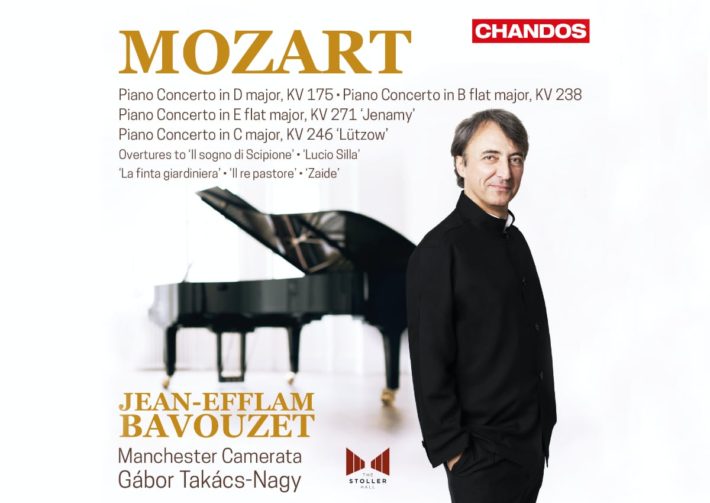This is the fifth installment of Jean-Efflam Bavouzet’s cycle of Mozart’s complete piano concertos. While the previous volume featured some of the composer’s later and most well-known concertos (No. 20 and 21, reviewed here), this recording goes back in time to feature his first original concerti and his not-often recorded early overtures.
Exploring the first CD of the two in this volume, the Fifth Piano Concerto (K. 175) reflects the youthful style of the then 17-year old composer. One of the trickiest performance aspects for pianists in Mozart concertos is to find a balance between a show of technique and collaborative ensemble playing; it is not difficult to get carried away with virtuosity. Bavouzet, however, captures the perfect balance – his playing is cohesive with the orchestra in articulation, sound quality, and character. He also knows when to step back to provide support for the orchestra. The tempo is a little brisk, but it does help maintain a sprightliness throughout. What is missing occasionally from the movement, however, is a sense of refinement that should balance out the high energy. There is not quite enough dynamic shading, particularly in moments where phrases echo. If you want a recording that highlights the elegance of Mozart’s writing and carries a more stately presence, turn to Vladimir Ashkenazy and Philharmonia Orchestra’s Decca recording from the mid-1980. Where the first movement saw cohesive ensemble playing, the second movement centers around dialogue: Mozart’s writing includes a considerable amount of melodic intertwining, and soloist and orchestra communicate most intricately. The cadenza, too, shows incredible nuance: despite its brevity, the soloist shows many beautiful shades of quiet piano playing.
Piano Concerto No. 6 (K. 238) was composed just 3 years after K. 175, but one can already hear considerable compositional development. The concerto shows Mozart’s exploration of harmonic language and instrumentation; the orchestra also seems to hold more presence, but that does not mean that soloist shines any less as a virtuoso. Performance-wise, this concerto is stronger than K. 175, particularly in the outer movements. In the first movement, Bavouzet implements noticeable color changes in repeated lines, and he brings forward Mozart’s increasing complexity in harmonic movement, faintly reminiscent of later concerti.
Bavouzet’s delicate touch in these early concertos makes particular aspects of his playing especially lovely to hear: occasionally, Mozart creates lines between the hands that have parallel movement. The pianist’s seamless coordination makes it sound like everything is played with just one hand. Bavouzet approaches the keyboard in such a way that there is a distinct amount of space between every note, creating a delightful clarity. The orchestra also helps to give the music its multidimensional character, complementing the dance-like lilt of the softer sections with broader, more symphonic sections. In reference to the latter, there is a solid presence of the horns and a strong performance from the lower strings. Consistent with previous volumes, Bavouzet’s playing, too, is also orchestral in nature: his left hand often reminiscent of the lower strings and his right of the violins and woodwinds.
Moving on to the second CD, there’s an endearing performance of the often overlooked Piano Concerto No. 8 (K. 246 “Lützow”), with its cheeky Turkish Finale. Both Bavouzet and the Manchester Camerata shine in K. 271 (“Jeunehomme”), the most well-loved and often performed Concerto in this volume. Many of the previously mentioned aspects of balance and ensemble collaboration are evident here as well, but what is striking about the performance of this concerto is its style. Where K. 175 could be characterized by its inbounding energy, K271 shows Mozart’s increasing maturity and refinement. The first movement is interesting in that the soloist enters in a rather unusual circumstance, not waiting for the orchestral introduction to be over, but instead almost interrupting the orchestra’s opening phrase and finishing it. Bavouzet executes this very well with a stately yet almost stubborn quality, almost as if to signal a command of the listener’s attention. The orchestra, too, reconciles elegance with larger-scale playing very nicely here, giving the movement quite the range of character. Another noticeable aspect is that the pianist uses the pedal sparingly, instead relying on a solid finger-legato. This is harder to execute technically for pianists, but the results are fruitful, as we hear Bavouzet’s smooth yet clear lines.
The second movement marks the first time in these early concerti that we hear a movement in the minor key. The opening has an effective pathos and drama (particularly in moments of unexpected harmonic movement), but the orchestral is mindful not to exploit these qualities, maintaining the refinement of the previous movement. The pianist’s playing, too, has its moments of strong emotion (such as at the end of his entrance) but also reserved nuance in the E-flat major sections. Communication plays a critical role in this movement: the dialogue of echoes at 7’06” – 7’27” is beautifully done, with impressive synchronicity in tonal color changes.
The final movement is a stellar finish to the work: Bavouzet’s virtuosity is on display here, but once again in moderation. There is an element of joyfulness and playfulness that comes from his excellent control of articulation and dynamics. There is an element of suspense at his cadenza (1’56”), where he takes just the right amount of time at pivotal points. It is these moments, juxtaposed with the energetic fast sections, that keep the movement fresh and exciting throughout. This is an excellent interpretation of this concerto and is quite possibly the best of the four he has presented here.
As in previous volumes, this album also includes several orchestral overtures. All works stay true to Mozart’s refined style, but a standout track is the Andante of the Overture to ‘Il sogno di Scipione’, (K. 126, track 7): there is synchronicity between woodwinds and strings, but even more striking is that the flutes and oboes shine in a highly lyrical performance. The strings, even as accompaniment for most of the movement, create depth with nice swells in long lines. The opening movement of the Overture to ‘Lucio Silla’ (K. 135, track 12) also makes for a delightful listen, with interesting character contrasts between different sections as when the winds come through as a smaller, yet highly coordinated ensemble.
The sound engineering is solid, allowing to hear nuanced balance in the orchestra as clearly as in the piano (a Yamaha CFX, also used on previous volumes in this series and on Bavouzet’s ongoing Haydn Sonatas cycle). With an album this enjoyable, all is left is to wait for the rest of this series in eager anticipation.

Mozart – Piano Concertos, Vol. 5
Piano Concerto No. 5-9 (“Jeunehomme”), early Overtures
Jean-Efflam Bavouzet – Piano
Manchester Camerata
Gábor Takács-Nagy – Conductor
Chandos, CHAN 20137(2)
Read more classical music reviews or visit The Classic Review Amazon store
Related Amazon Items
Album Review Log Book: 8.5×11″ – Music Albums Listening Journal – Album Rating Notebook – Album Evaluation Score Sheet Book – Rate, Record, Track Your … with Table of Contents & Pre-Numbered Pages
$9.99 (as of December 12, 2025 04:27 GMT +02:00 – More infoProduct prices and availability are accurate as of the date/time indicated and are subject to change. Any price and availability information displayed on [relevant Amazon Site(s), as applicable] at the time of purchase will apply to the purchase of this product.)Led Zeppelin – Physical Graffiti: A Classic Album Under Review
$4.99 (as of December 12, 2025 04:27 GMT +02:00 – More infoProduct prices and availability are accurate as of the date/time indicated and are subject to change. Any price and availability information displayed on [relevant Amazon Site(s), as applicable] at the time of purchase will apply to the purchase of this product.)AC/DC – Classic Album Under Review: Back In Black
ALBUM REVIEWS
$1.29 (as of December 12, 2025 04:27 GMT +02:00 – More infoProduct prices and availability are accurate as of the date/time indicated and are subject to change. Any price and availability information displayed on [relevant Amazon Site(s), as applicable] at the time of purchase will apply to the purchase of this product.)Music Album Review Log: Musical song and album rating and recording logbook | Track, rate and reflect on music albums you listen to | Professional black cover design
Follow Us and Comment:
[wd_hustle id=”HustlePostEmbed” type=”embedded”]
























